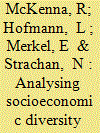|
|
|
Sort Order |
|
|
|
Items / Page
|
|
|
|
|
|
|
| Srl | Item |
| 1 |
ID:
150019


|
|
|
|
|
| Summary/Abstract |
Adequately accounting for interactions between Low Carbon Technologies (LCTs) at the building level and the overarching energy system means capturing the granularity associated with decentralised heat and power supply in residential buildings. The approach presented here adds novelty in terms of a realistic socioeconomic differentiation by employing dwelling/household archetypes (DHAs) and neighbourhood clusters at the Output Area (OA) level. These archetypes are combined with a mixed integer linear program (MILP) to generate optimum (minimum cost) technology configurations and operation schedules. Even in the baseline case, without any LCT penetration, a substantial deviation from the standard load profile (SLP) is encountered, suggesting that for some neighbourhoods this profile is not appropriate. With the application of LCTs, including heat pumps, micro-CHP and photovoltaic (PV), this effect is much stronger, including more negative residual load, more variability, and higher ramps with increased LCT penetration, and crucially different between neighbourhood clusters. The main policy implication of the study is the importance of understanding electrical load profiles at the neighbourhood level, because of the consequences they have for investment in the overarching energy system, including transmission and distribution infrastructure, and centralised generation plant. Further work should focus on attaining a superior socioeconomic differentiation between households.
|
|
|
|
|
|
|
|
|
|
|
|
|
|
|
|
| 2 |
ID:
121355


|
|
|
|
|
| Publication |
2013.
|
| Summary/Abstract |
The new federal government in the German federal state of Baden-Württemberg has set a target for 10% of gross electricity generation from wind energy by 2020. Given that currently around 0.1% of the electricity generation comes from wind energy, this paper examines the technical feasibility and economic costs associated with realising this goal. The technical potential for wind energy in Baden-Württemberg is determined, along with the costs of electricity generation, which together lead to the derivation of cost-potential-curves. The technical potential is calculated by identifying the available area with the aid of a geographical information system (GIS) and land use information. With the help of a regional wind atlas, turbine power curves and an assumed wind speed frequency distribution, the spatially distributed electricity generation potential on a district level is estimated. The costs of wind energy are investigated for the year 2010 and projected for the years 2020 and 2030 on the basis of learning curves. The result is a suitable area for wind energy of 2119 km², which amounts to 5.9% of the total area of Baden-Württemberg. Depending on the wind turbine selected, a capacity of 18.5 GW up to 24.5 GW could be installed and depending on the hub height and the turbine, an electricity yield of 29.3 TWh up to 40.7 TWh could be generated. The costs of electricity, depending on the type of turbine and the average wind speed, but lie for 2010 between 3.99 and 21.42 €-cents/kWh, reducing by 2030 to 3.33-17.84 €-cents/kWh.
|
|
|
|
|
|
|
|
|
|
|
|
|
|
|
|
| 3 |
ID:
174952


|
|
|
|
|
| Summary/Abstract |
A recent article in this journal claimed to assess the socio-technical potential for onshore wind energy in Europe. We find the article to be severely flawed and raise concerns in five general areas. Firstly, the term socio-technical is not precisely defined, and is used by the authors to refer to a potential that others term as merely technical. Secondly, the study fails to account for over a decade of research in wind energy resource assessments. Thirdly, there are multiple issues with the use of input data and, because the study is opaque about many details, the effect of these errors cannot be reproduced. Fourthly, the method assumes a very high wind turbine capacity density of 10.73 MW/km2 across 40% of the land area in Europe with a generic 30% capacity factor. Fifthly, the authors find an implausibly high onshore wind potential, with 120% more capacity and 70% more generation than the highest results given elsewhere in the literature. Overall, we conclude that new research at higher spatial resolutions can make a valuable contribution to wind resource potential assessments. However, due to the missing literature review, the lack of transparency and the overly simplistic methodology, Enevoldsen et al. (2019) potentially mislead fellow scientists, policy makers and the general public.
|
|
|
|
|
|
|
|
|
|
|
|
|
|
|
|
|
|
|
|
|